
Henrike Naumann. Photo: Inga Selck
by IZABELLA SCOTT
Henrike Naumann (b1984) grew up in Zwickau, in East Germany. Her installations restage living spaces of the 1990s – teenage bedrooms, living rooms and high street shop interiors – rebuilt in detail with period furnishings. For East Germans, the 90s was a time of immense social change; with the fall of the GDR in 1989, there came an influx of western models of liberalism and neoliberalism – shopping malls, showrooms. It was also during this decade that rightwing extremism emerged in the east; Zwickau later became infamously associated with the National Socialist Underground (NSU), a neo-nazi terror group that lived in hiding, among the newly bourgeoisie residents.
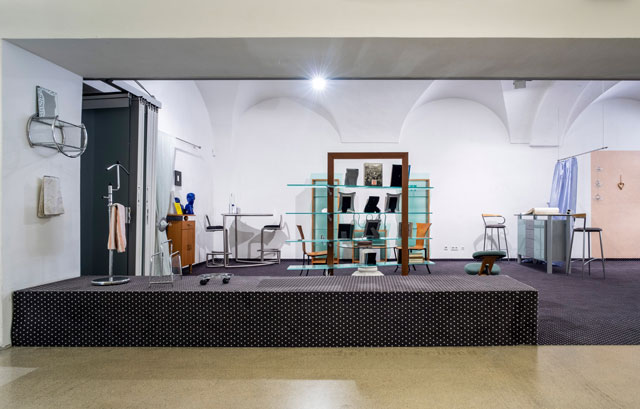
Henrike Naumann: Anschluss ‘90, 2018. Photo: Mathias Völzke
Naumann looks for signs of far-right ideology in the very ordinary objects that make up domestic, interior spaces – bar stools, CD racks, wallpaper. Her work poses the questions: does radicalisation have an aesthetic register?; can the objects we live with be psychologically analysed; can they tell us about longings, desires and beliefs?
I came across Naumann’s work in Graz, Austria, as part of the 51st iteration of Steirischer Herbst (2018), an interdisciplinary arts festival curated by Ekaterina Degot. This year, under Degot’s eye, the festival took a decidedly political turn, themed around the word Volksfronten, a politically loaded term, with roots in the far-right (Volk, the German for “people”, took on ethnic dimensions during the Nazi period, and has since been deployed by white supremacist groups in the US, such as the 90s organisation Volksfront) and the far-left (“front” is for the Popular Front, an alliance of anti-fascist movements in 1930s Europe). As part of the Steirischer Herbst festival, Naumann created the installation Anschluss ’90, which took over the Haus der Architektur in the city centre.
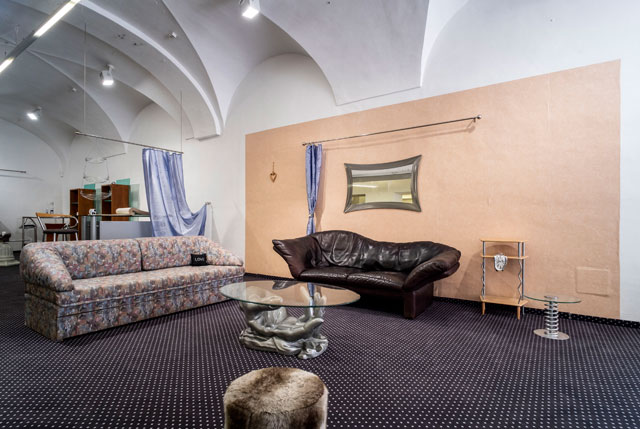
Henrike Naumann: Anschluss ‘90, 2018. Photo: Mathias Völzke
Izabella Scott: You have transformed Graz’s Haus der Architektur into a furniture showroom from 1990. It is full of kitsch postmodern furniture: leather couches, lava lamps, stretched mirrors on the wall and turquoise-tinted champagne glasses. Some objects are familiar, others feel a little sinister. Where did you find them?
Henrike Naumann: All were sourced in Graz and the surrounding area. I went to many flea markets and also bought things on willhaben.at, which is the Austrian version of eBay and translates as “want, have”. In some ways, I knew what I was looking for: objects that expressed the ideology of the 90s, which for East Germans like me was a period of immense change – the end of the German Democratic Republic with German unification in October 1990, and the spread of economic liberalism into the east and, with it, the rise of the new far right. For the past seven years, this is what my practice has been about: looking back to the 90s to try to understand the roots of rightwing radicalism, predominantly in East Germany, but also across Germany and in Austria, too.
IS: The language in which you choose to speak about the rise of the far right is that of the private, domestic space, or interior design. Why?
HN: I’ve always worked with furniture, wallpaper, carpets, and I started out as a film scenographer. Over time, I began to realise that domestic interiors were a kind of documentary form. For this installation in Graz, I have taken us back in time. This furniture showroom is supposed to have opened overnight, really quickly, just after German unification in 1990. For Germans, unification was not anticipated, and it seemed to happen very suddenly. The process was very rushed, and there were a lot of compromises during the unity treaty. An example is East German workers’ pensions, which were put in the western system, and a lot of workers – for example, divorced females – lost their right to a pension. It was all so rushed, but everybody was like: “We just have to make history!” These women are still fighting for their right to an adequate pension. In my version of the 1990 unification, a wave of popular sentiment floods into Austria, into Graz, so that Germany and Austria are rejoined, too, in Anschluss ’90.
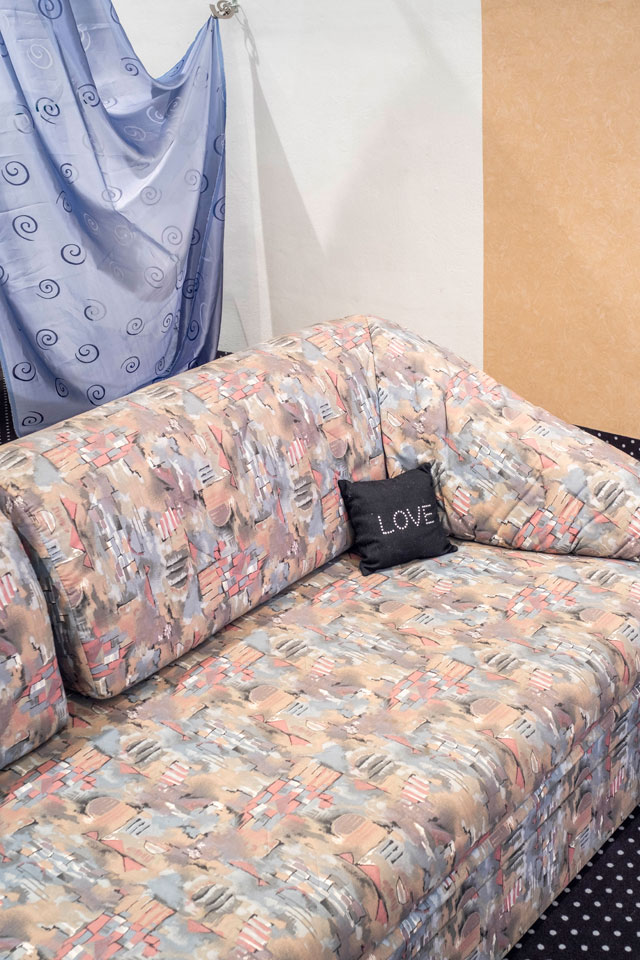
Henrike Naumann: Anschluss ‘90, 2018. Photo: Mathias Völzke
IS: Anschluss is a very potent word in the history books, referring to the annexation of Austria by Nazi Germany in 1938. Is it meant to be triggering? Is there anybody who might support this?
HN: Anschluss means “joining” in German, but it’s also, of course, the historical event, Anschluss ’38. The far right has a long history in Austria and major questions still surround Anschluss ’38. Was it forced or voluntary? Were the Austrians victims, or not? When I put together this installation, I was thinking about the Freedom Party of Austria, which was set up in the 1950s by Anton Reinthaller, a former Nazi minister and SS officer. It had a relatively small following until the 90s, when it really took off, under the leadership of Jörg Haider. He was a poster boy of the new right and made the party immensely popular. Part of the furniture showroom was inspired by what could have been Haider’s workroom, or study. I left his autobiography on one of the shelves.
Because of my experience growing up in East Germany, the rise of the far right is connected, in my mind, to the rise of neoliberalism. Both hit East Germany across the 90s, in the aftermath of unification. In West Germany, this happened over several decades, but in East Germany, it was condensed, and it happened in an accelerated way. You could see how neoliberal ideals destroy places, destroy society. We are now in the ruins of globalisation: this is the place where neoliberalism has brought us. And it’s out of those ruins that the far right rose up. They promise to rebuild nations, rebuild places.
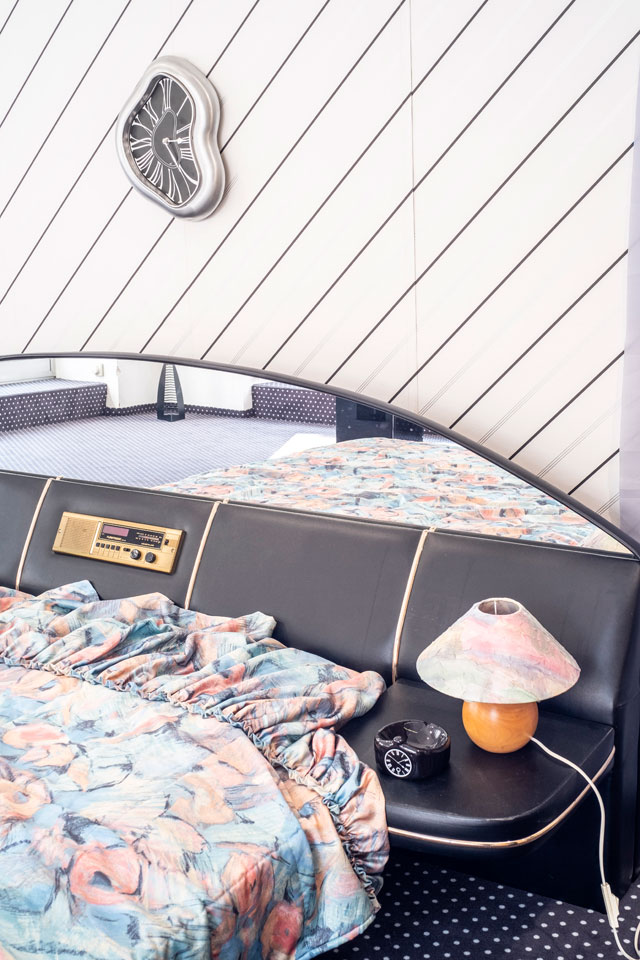
Henrike Naumann: Anschluss ‘90, 2018. Photo: Mathias Völzke
In Haider’s part of the room, two stiff chairs sit either side of a glass table and, on the table, is a very ugly tissue box, shaped like a sofa. I was thinking of this as a place where people can come and cry, or talk with a therapist about what went wrong.
IS: You seem to see this loss of place evoked by the de-localisation of the interior. Yet the objects in this showroom feel very German, or at least European.
HN: There’s a regionality to the objects on display, but many of them are products of globalisation, which began in the 1980s. Tellingly, this new Anschluss ’90 is not marked by military parades, but by shopping. The showroom is full of furniture that psychologically resembles unification. I have objects that cling together, or melt together into each other – like two hearts that join in the form of a kitschy picture frame on a nightstand. Along the way, I found objects that seemed ideologically explicit. Take one table: a sheet of glass held up by a silver hand with a pointing finger. It speaks of a longing for leadership in Europe, and the “strong hand” that will lead is at the heart of rightwing populism. Or take a second table: a sheet of glass held up by a neoclassical ruin. The right is nostalgic, obsessed by narratives of decline, this “make us great again” slogan that harks back to a symbolic golden age – Ancient Rome, neoclassicism – which is actually a total fantasy.
IS: In the showroom, different elements combine: mass-produced postmodernism, such as the Dalí clock that melts down the wall, and then folk pieces that you have woven in, such as the ashtray made out of a deer’s hoof. There is something uncomfortable about the combination. Did you intend the folk elements to become so sinister?
HN: I found the deer-hoof ashtray at a flea market in Graz, just a week before the show opened. I don’t find it the most sinister part. Above the deer hoof is a metal shelf, which I also found in Graz, from someone’s private home. It has a devil’s tail in the design and it was something I was very disturbed by. I began to think about whether it was possible for an aesthetic, or region, to be somehow diabolic.
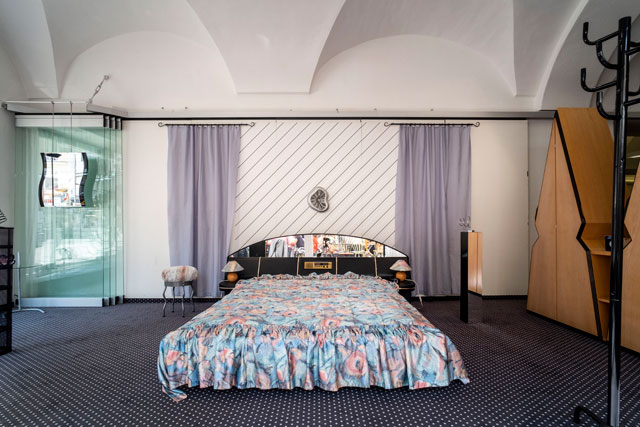
Henrike Naumann: Anschluss ‘90, 2018. Photo: Mathias Völzke
IS: Are you moralising the interior space? Or pathologising it – reading every object as a symptom of certain attitudes, certain politics?
HN: To some extent, yes. I’m looking at the private space in relation to society and reading fear, longing, desire or ambition into interior design. No matter where I go across Germany, and now Austria, I always find these 90s objects; there is a shared history that is still visible in aesthetics. It’s such a particular language, and I really see fascism in the furniture. I see something evil: it’s as if something I can establish as evil lies in these everyday objects.
IS: When you say “evil”, do you mean that these objects carry some message of hate?
HN: I think of the Haus der Architektur, like this one in Graz, as a potent space, where a concept for society is shown – where society is shown how to live. People have often asked me: “Are you implying that, if I buy this table, I may be in danger of radicalisation?” Of course, it’s not as simple as this. But, at the same time, I also see a relationship between mass-produced design of the 90s and populist ideology. It’s important to remember that individualism as a concept links capitalism and fascism. We tend to think of capitalism and fascism as poles apart, but, historically speaking, liberalism gave birth to fascism.
To refurbish is also to cover up. The carpet, which covers the entire floor of the showroom, creates this seamless environment. It’s black with white spots, and I was thinking directly of the graphic design used in the early 90s by rightwing populist parties, such as the Republicans, the national conservative party of Germany. They had these party stickers, with clipart jokes alongside the German flag – innocent prints and colours that my Anschluss ’90 store logo imitates.
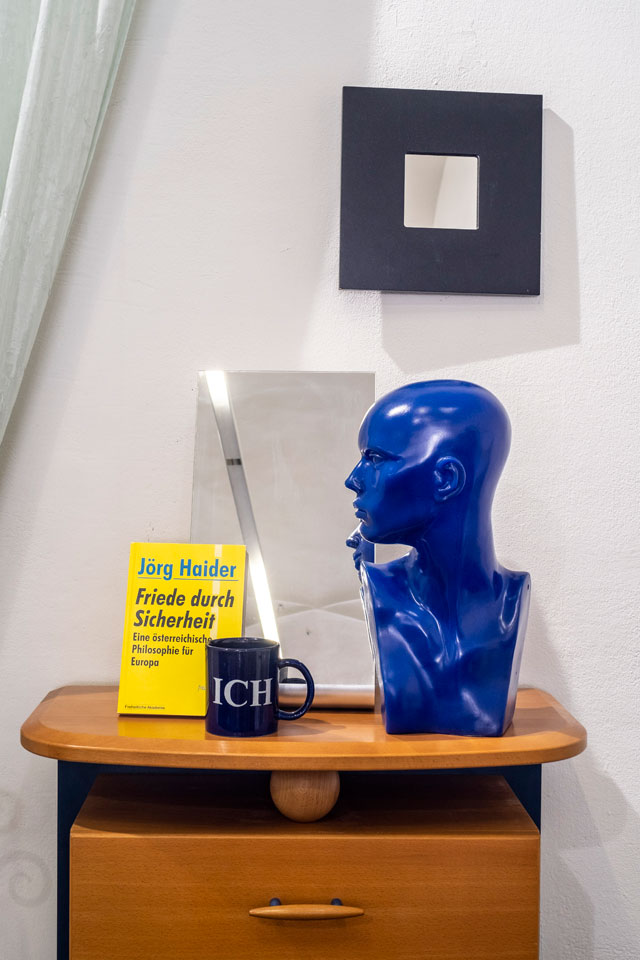
Henrike Naumann: Anschluss ‘90, 2018. Photo: Mathias Völzke
IS: On one of the shelves, a section of the black spotted carpet sits in a little picture frame like a family photograph. It’s a clear moment of taking the aesthetic out of context – of trying to encourage the viewer to really examine it.
HN: As I mentioned before, I began working as a scenographer, before I transitioned into making installations, or identifying as an artist. I’ve always been interested in looking at very normal, useless or valueless objects. I want to bring attention to these objects and to create a space to think about them more closely. So, how do I frame these everyday objects to become more than what they are? From my youth, I remember the influx of these objects into East Germany across the 90s. They were already valueless when they arrived; they had been used and discarded by West Germans in the decade before. For the entire eastern bloc, there’s often a sense of secondhand time. These objects, materials and designs held so much meaning at one point in the past. When the iron curtain fell, they represented the future, or being part of the western world, or becoming a new citizen. But they have also let people down. I want to show how feelings of hope and longing are aesthetically represented by these valueless objects. And now, looking at the objects again, they seem to speak of globalisaton, rootlessness, of the way people feel left out or lost.
IS: When you buy these objects online, do you feel that Austrians are shedding these objects, somehow moving on from this point in the past?
HN: Not really. Most of these objects come directly from people’s homes – not from storage, or the cellar, but right out of Austrian people’s lives. And what I have collected here is only a fraction of what’s available. I often feel as if I’m the only person interested in buying these objects; if I didn’t pick up this sofa or that table, they would just remain there, in the living room. They are pieces of history that don’t seem to go away.
IS: Some of the objects are weird, in a way that’s only possible to see, perhaps, once they have been taken out of context. For example, there is a pair of pointed cupboards, like church steeples, which I find sinister; I thought immediately of the Ku Klux Klan.
HN: I think it’s only when you take these object out of the home, and put them into another context, that you can see them anew. And you might think: God, how have I been living with these things? I often think about radicalistion, or the aesthetic of radicalisation. It’s not something necessarily spectacular; on the contrary, it might be something entirely banal. In my work Triangular Stories (2012), I created 90s home videos that showed the interior spaces of teenagers living in the East German town of Jena. I grew up nearby, in Zwickau (60km east). Jena is the place where some members of the National Socialist Underground grew up. The NSU is a neo-Nazi terror group, uncovered in 2011, which murdered nine immigrants across the 00s, and committed various bombings and robberies in the 90s. They later went into hiding in Zwickau.
I recreated the bedrooms of imagined teenagers associated with the NSU, trying to find the point in the 90s when they were radicalised, speaking about radical ideology through everyday objects. What is spooky is seeing how radicalisation can also be seamless with the world we know. These bedrooms I created, like the furniture showroom, are full of very familiar objects, things people used to own in the 90s, or used to love as teenagers. Perhaps it’s through such objects that we can begin to have a different conversation about the phenomenon of rightwing terrorism, as something that is not on the margins, but very, very close by.
IS: This takes us to the present – a moment when neo-nazism is no longer a sensational narrative. It’s a fact. Do you feel the conversation around your work has changed in recent years?
HN: In Germany, rightwing radicalism has become mainstream. Five years ago, the idea of reading fascism into design was something I had to fight to establish in my work. But in recent years that’s changed, mostly due to the escalation of the political situation. This year, for example, there have been several exhibitions focusing on fascism – such as the Steirischer Herbst ’18 here in Graz – which before didn’t happen. Fascism just wasn’t seen as a big enough problem.
I’m currently installing an exhibition in Frankfurt, part of Because I Live Here, a group show at the modern art museum MMK (Museum für Moderne Kunst), in the middle of the banking district. The installation is called 14 Words and, for it, I’ve transported a 90s flower store from East Germany to Frankfurt. After rebuilding it, I will fill it with objects: no flowers, only empty vases. The group exhibition looks to racism in Germany, going back to the 1970s. I’ve been looking back to the roots of contemporary white supremacism and a neo-Nazi group known as the Order, who were active in the US in the 1980s. One of the group’s founding members, David Lane, established the Fourteen Words, a set of slogans derived from Hitler’s Mein Kampf, that have formed the basis of white supremacism. The most famous slogan is: “We must secure the existence of our people, and a future for white children.”
The store I’m building in Frankfurt will speak about the ideology of the Fourteen Words – this idea that some white people think they are in an eternal racial war, to create a “clean” society. It also refers to the killings of the NSU, which often killed people in their stores, shooting owners behind their desks. Their first victim was a flower seller named Enver Şimşek, who was killed in Nuremberg in 2000. The empty vases that will fill this store are white, some with holes in them, and which look like they have been shot, or pierced. I’m interested in this tension, this material violence.
When I make work, I’m always thinking about a point in the past, but it’s never historic examination. It’s about the present – or at least an attempt to try to find a way out of this present moment. I’m looking back at the point at which something started – rightwing populism, fascism, neo-nazism – that is now in full swing.
• Henrike Naumann’s installation 14 Words is part of the group exhibition Because I Live Here at the Museum für Moderne Kunst, Frankfurt, until 31 March 2019.